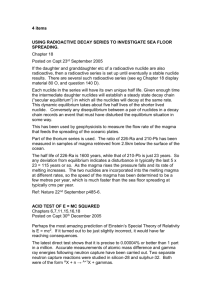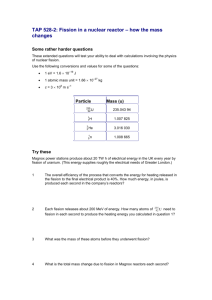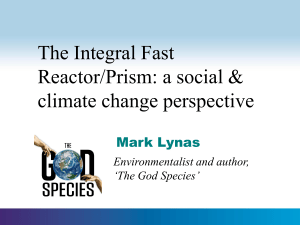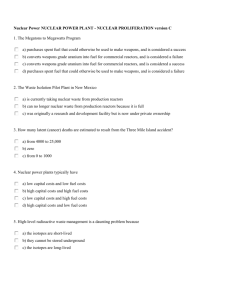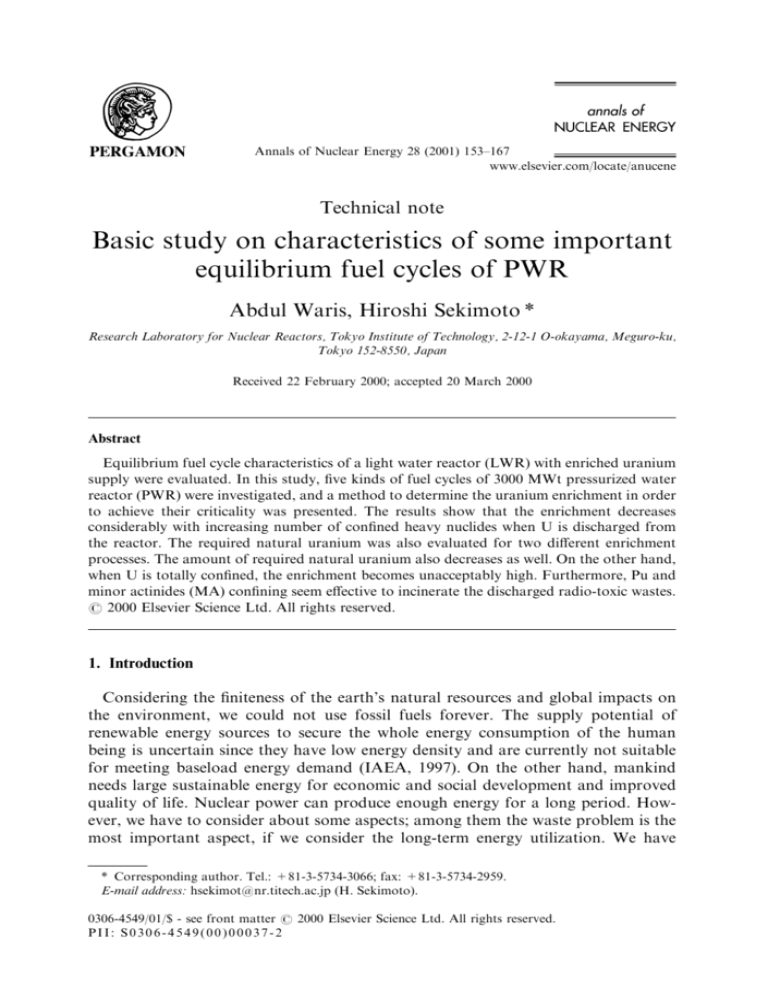
Annals of Nuclear Energy 28 (2001) 153±167
www.elsevier.com/locate/anucene
Technical note
Basic study on characteristics of some important
equilibrium fuel cycles of PWR
Abdul Waris, Hiroshi Sekimoto *
Research Laboratory for Nuclear Reactors, Tokyo Institute of Technology, 2-12-1 O-okayama, Meguro-ku,
Tokyo 152-8550, Japan
Received 22 February 2000; accepted 20 March 2000
Abstract
Equilibrium fuel cycle characteristics of a light water reactor (LWR) with enriched uranium
supply were evaluated. In this study, ®ve kinds of fuel cycles of 3000 MWt pressurized water
reactor (PWR) were investigated, and a method to determine the uranium enrichment in order
to achieve their criticality was presented. The results show that the enrichment decreases
considerably with increasing number of con®ned heavy nuclides when U is discharged from
the reactor. The required natural uranium was also evaluated for two dierent enrichment
processes. The amount of required natural uranium also decreases as well. On the other hand,
when U is totally con®ned, the enrichment becomes unacceptably high. Furthermore, Pu and
minor actinides (MA) con®ning seem eective to incinerate the discharged radio-toxic wastes.
# 2000 Elsevier Science Ltd. All rights reserved.
1. Introduction
Considering the ®niteness of the earth's natural resources and global impacts on
the environment, we could not use fossil fuels forever. The supply potential of
renewable energy sources to secure the whole energy consumption of the human
being is uncertain since they have low energy density and are currently not suitable
for meeting baseload energy demand (IAEA, 1997). On the other hand, mankind
needs large sustainable energy for economic and social development and improved
quality of life. Nuclear power can produce enough energy for a long period. However, we have to consider about some aspects; among them the waste problem is the
most important aspect, if we consider the long-term energy utilization. We have
* Corresponding author. Tel.: +81-3-5734-3066; fax: +81-3-5734-2959.
E-mail address: hsekimot@nr.titech.ac.jp (H. Sekimoto).
0306-4549/01/$ - see front matter # 2000 Elsevier Science Ltd. All rights reserved.
PII: S0306-4549(00)00037-2
154
A. Waris, H. Sekimoto / Annals of Nuclear Energy 28 (2001) 153±167
studied the future nuclear energy utilization in an equilibrium state, which may
become the most probable condition in the far future.
In the previous studies on the future nuclear equilibrium society, only natural
uranium and/or thorium were used as supplied fuel (Sekimoto and Takagi, 1991;
Mizutani and Sekimoto, 1997). These studies showed that LWR could not perform
its criticality. Furthermore, only one sort of fuel cycle, i.e. all heavy metals (HMs)
con®ning, was studied. However, if enriched uranium is used as fed fuel the reactor
can be critical and many systems are possible in LWRs.
In this work, a method to calculate the uranium enrichment required for criticality
of reactor is proposed. Then PWR system fueled with enriched uranium for dierent
fuel cycle cases are studied, and the required amount of enriched uranium and natural
uranium are evaluated to investigate whether the system can perform Pu and minor
actinides recycling eciently or not. In addition, the radio-active toxicity of spent
fuel of each case is evaluated.
This paper is organized as follows. Section 2 describes the reactor model parameters and fuel cycle options used in this study. The calculation methods are
explained in Section 3, followed by mentioning the numerical results in Section 4.
Finally, the conclusions are presented in Section 5.
2. Reactor model and fuel cycle options
In this paper, 3000 MWt PWR systems are investigated. The basic reactor model
parameters are tabulated in Table 1. The average power density in fuel pellet was
®xed to 280 W/cc, which results in the cell-averaged power density of 100 W/cc.
The following ®ve important fuel cycle cases are studied, where all ®ssion products
(FP) and ®nal products of HM natural decay chain (Tl±Fr) are discharged from the
reactor at certain rate.
. Case 1: All HMs are discharged from the reactor.
. Case 2: All HMs except Pu are discharged from the reactor. Pu is discharged at
the rate of one-half of the other HM discharge constant.
. Case 3: All HMs except Pu are discharged from the reactor. Pu is con®ned in
the reactor.
. Case 4: All HMs except U are con®ned in the reactor. U is discharged from the
reactor.
. Case 5: All HMs are con®ned in the reactor.
Table 1
Reactor model parameters of studied PWR
Power output (MW thermal)
Average power density in Pellet (W/cc)
Fuel pellet diameter (mm)
Fuel rod diameter (mm)
3000
280
8.0
9.6
A. Waris, H. Sekimoto / Annals of Nuclear Energy 28 (2001) 153±167
155
In the present study we use three discharge constants, i.e. 25, 33 and 50%/year.
The discharge constant of 25% per year is corresponding to the four batches fuel
loading in the standard reactor operation whose cycle length is 1 year. We consider
this condition as a high burnup core. The discharge constant of 33% per year, which
corresponds to the three batches per cycle, was chosen as a standard discharge constant in this study (Todreas and Kazimi, 1990). We also use 50% per year of discharge
constant for comparison and to see the reasonable tendencies. These all investigated
cases are summarized in Table 2.
3. Methods of calculation
3.1. Equilibrium state and criticality
The nuclear-equilibrium state in the present study is considered to satisfy the following conditions:
. Number density of each nuclide in reactor is constant.
. Refueling process is a continuous process.
In these conditions the number density of the ith nuclide, ni , should satisfy the
following equation:
X
X
dni
ÿ
li a;i ri ni
lj ! i nj j ! i nj si 0;
dt
j
j
1
where
:
neutron ¯ux,
decay constant of ith nuclide,
li :
discharge constant of ith nuclide,
ri :
lj ! i : decay constant of jth nuclide to produce ith nuclide,
j ! i : microscopic transmutation cross-section of jth nuclide to produce ith nuclide,
Table 2
Discharge constant for each casea
Case
U
Pu
Other HMs
1
2
3
4
5
r
r
r
r
0
r
r/2
0
0
0
r
r
r
0
0
a
r is chosen to be 25, 33 and 50%/year in the present study.
156
A. Waris, H. Sekimoto / Annals of Nuclear Energy 28 (2001) 153±167
si :
a;i :
supply rate of ith nuclide,
microscopic absorption cross-section of ith nuclide.
Here, the absorption cross-section includes not only ®ssion and capture crosssections but (n, 2n) and other nuclear transmutation cross-sections also. The formation of ®ssion products can be estimated by substituting j ! i in Eq. (1) with the
following equation:
j ! i f;j j ! i ;
2
where
f; j
j ! i
microscopic ®ssion cross-section of jth nuclide,
yield of ith nuclide from jth ®ssile nuclide.
Eq. (1) can be written in a matrix form as follows:
Mn s;
3
where all coecients in Eq. (1) compose the elements of M matrix, and n and s are
the vectors of ni and si , respectively.
The one-group microscopic cross-sections in Eq. (1) changes for dierent fuel
cycles. However, since the present study is general and introductory, the same standard values are employed for all cases. These standard cross-sections are evaluated
for the fresh fuel cell whose fuel enrichment is 3.5% of U-235 by using SRAC code
(Tsuchihashi et al. 1994). Nuclear data are prepared from JENDL-2, -3.1, -3.2 and
ENDF/B-IV, -V, -VI. The neutron spectrum obtained in this calculation is shown in
Fig. 1.
To evaluate the criticality of the system, h-value, de®ned by
h
f ; n
;
a ; n
4
is commonly used in the equilibrium state analyses (Sekimoto and Nemoto, 1997),
where represents the number of neutrons produced in one ®ssion reaction. The hvalue is a ratio of the number of produced neutrons by ®ssion and the number of
absorbed neutrons in the system. In importance vector representation, Eq. (4) can be
written as the following equation (Sekimoto and Nemoto, 1997):
h
f; s
;
a; s
5
where importance vectors f and a are calculated from the following adjoint
equations:
A. Waris, H. Sekimoto / Annals of Nuclear Energy 28 (2001) 153±167
157
Fig. 1. Neutron spectrum used in this study.
Mt f f ;
Mt a a ;
6
where Mt is the adjoint matrix of M. We call f and a neutron production importance
and neutron absorption importance, respectively.
3.2. Uranium enrichment for criticality
The uranium enrichment to satisfy the criticality condition of the reactor for each
case is determined as follows. The equilibrium calculation is performed to determine
a ¯ux level. In this calculation, 129 heavy nuclides and 1238 ®ssion products are
employed. Then we calculate the neutron production importance and the neutron
absorption importance of fuel nuclides U-234, U-235 and U-238. We can evaluate
the h-value of each system from the supply densities of fuel nuclides and their
importances. Finally, uranium enrichment for criticality is evaluated by solving the
following three linear equations:
f24 ÿ 1:06a24 s24
f25 ÿ 1:06a25 s25
f28 ÿ 1:06a28 s28 0;
7
158
A. Waris, H. Sekimoto / Annals of Nuclear Energy 28 (2001) 153±167
s24 s25 s28 100;
8
100s24 ÿ 0:9937s25 ÿ0:1925;
9
where sx is an atomic percent of uranium isotopes (U-234, U-235 and U-238) in the
supplied fuel.
Our standard PWR cell calculation shows that criticality can be attained for the hvalue of more than 1.06. Eq. (7) is derived from Eq. (5). Eq. (9) shows the relation
between the U-234 and the U-235 through enrichment process. This equation is
derived from data given in Hansen and Paxton (1979).
The ¯ow diagram of all calculation processes to evaluate uranium enrichment for
each fuel cycle case is shown in Fig. 2.
Fig. 2. Flowchart of uranium enrichment calculation.
A. Waris, H. Sekimoto / Annals of Nuclear Energy 28 (2001) 153±167
159
Fig. 3. Block diagram of enrichment process.
3.3. Natural uranium supply
For estimating the amount of required natural uranium, two dierent enrichment
processes are adopted where the concentration of U-235 in the tail is chosen as 0.3
and 0.1 w/0, respectively.
The calculation procedure is explained by using the notations shown in Fig. 3. The
total rate of required enriched uranium for each case, S1 , is determined from the
equilibrium calculation together with the neutron ¯ux level as mentioned before.
The total supply rate of natural uranium to produce S1 can be obtained from the
following equation:
S0
e1 ÿ e2
S1
e0 ÿ e2
10
Based on the total supply rate of natural uranium, we calculate the required
amount of natural uranium.
3.4. Radio-active toxicity
There are many methods for investigating the radio-active toxicity of spent fuel.
However, in this paper we use the annual limit on intake (ALI) for the public, which
was de®ned as the following equation (ICRP, 1990):
160
A. Waris, H. Sekimoto / Annals of Nuclear Energy 28 (2001) 153±167
ALI
0:001
;
e
50
11
where e
50 is an eective dose coecient. In the present study, only e
50 values for
ingestion were employed. These data are taken from ICRP Publication 68 (ICRP, 1995).
Toxicity of each ith heavy nuclide is given by the following equation:
Toxicityi
li Ni
;
ALIi
12
where ALIi is the annual limit on intake of the ith nuclide (Bq), and Ni is the number
of the ith nuclide.
We evaluate the toxicity along the decay time up to 1 million years without any
cooling process by employing the fourth-order Runge±Kutta method.
4. Calculation results
The required enrichment and amount of charged fuel to achieve the criticality of
the reactor are listed in Table 3 for several discharge constants. The required
Table 3
Required enrichment and amount of charged fuel per year
Case
Enrichment
(w/0)
Charged fuel
(tons/year)
Burnup
(GWd per ton charged fuel)
Required Natural U
(tons/year)
0.1 w/0 tail
0.3 w/0 tail
(a) Discharge constant=25%/year
1
5.9
22.2
2
5.4
22.0
3
5.1
21.9
4
4.8
21.6
5
77.0
1.2
49.5
49.7
50.1
50.6
937.3
209
193
180
167
147
300
276
257
237
218
(b) Discharge constant=33%/year
1
4.0
29.2
2
3.7
29.0
3
3.4
28.8
4
3.2
28.5
5
70.2
1.2
37.6
37.7
38.0
38.4
937.3
188
170
156
144
134
265
238
218
201
199
(c) Discharge constant=50%/year
1
2.7
44.1
2
2.3
43.9
3
2.1
43.6
4
2.0
43.1
5
61.8
1.2
24.9
25.0
25.2
25.4
937.3
186
162
141
132
118
254
219
188
176
175
A. Waris, H. Sekimoto / Annals of Nuclear Energy 28 (2001) 153±167
161
amount of the natural uranium and burnup are also tabulated in the same tables.
Here in, the burnup means how much energy is produced from 1 ton charged fuel.
As can be seen in these tables, for cases 1±4, where uranium is not con®ned, the
enrichment decreases considerably with increasing number of con®ned nuclides in
the reactor. On the other hand, the quantity of charged fuel reduces little. Then, the
amount of required natural uranium decreases considerably with increasing number
of con®ned nuclides.
Table 4
Importance values of some important nuclides
Importance Case U-234 U-235 U-236 U-238 Np-237 Pu-239 Pu-240 Pu-241 Pu-242 Am-243 Cm-244
(a) Discharge constant=25%/year
f
1
2
3
4
5
0.699
0.665
0.624
0.609
2.529
1.397
1.374
1.347
1.358
2.527
0.253
0.305
0.407
0.729
2.929
0.098
0.100
0.102
0.105
2.933
0.801
1.034
1.503
2.884
2.941
2.187
2.396
2.701
2.946
2.949
1.799
2.039
2.403
3.073
3.082
1.989
2.153
2.402
3.073
3.082
0.607
0.731
0.975
3.477
3.505
1.022
0.986
0.944
3.483
3.511
1.236
1.207
1.175
3.483
3.512
a
1
2
3
4
5
0.943
0.902
0.851
0.836
3.165
0.942
0.920
0.896
0.924
2.214
0.732
0.765
0.847
1.283
5.157
0.116
0.116
0.117
0.117
3.337
1.514
1.754
2.255
4.176
4.297
1.815
2.004
2.301
2.493
2.567
2.231
2.501
2.954
3.503
3.545
1.474
1.649
1.960
2.510
2.552
1.471
1.815
2.500
4.524
4.478
1.570
1.546
1.522
3.575
3.529
0.928
0.921
0.924
2.592
2.546
(b) Discharge constant=33%/year
f
1
2
3
4
5
0.518
0.483
0.437
0.421
2.529
1.233
1.200
1.158
1.157
2.527
0.146
0.180
0.260
0.550
2.929
0.067
0.069
0.072
0.074
2.933
0.565
0.766
1.249
2.873
2.941
2.030
2.280
2.673
2.945
2.949
1.604
1.877
2.326
3.071
3.081
1.839
2.025
2.324
3.071
3.082
0.390
0.484
0.706
3.471
3.504
0.753
0.715
0.671
3.476
3.510
0.970
0.938
0.903
3.477
3.511
a
1
2
3
4
5
0.726
0.684
0.629
0.612
3.118
0.788
0.761
0.728
0.745
2.166
0.494
0.509
0.567
0.959
5.105
0.079
0.079
0.081
0.082
3.284
1.156
1.355
1.859
4.115
4.244
1.625
1.841
2.214
2.437
2.508
1.985
2.281
2.830
3.458
3.493
1.284
1.467
1.835
2.465
2.500
1.144
1.471
2.243
4.527
4.472
1.326
1.295
1.261
3.579
3.523
0.744
0.734
0.734
2.595
2.540
(c) Discharge constant=50%/year
f
1
2
3
4
5
0.306
0.277
0.235
0.223
2.529
0.985
0.943
0.882
0.870
2.527
0.059
0.074
0.124
0.351
2.929
0.037
0.039
0.042
0.045
2.933
0.301
0.441
0.901
2.858
2.941
1.765
2.075
2.639
2.944
2.949
1.301
1.624
2.232
3.067
3.081
1.611
1.835
2.230
3.068
3.081
0.177
0.231
0.401
3.461
3.503
0.431
0.400
0.362
3.467
3.510
0.630
0.602
0.570
3.467
3.510
a
1
2
3
4
5
0.473
0.437
0.386
0.371
3.060
0.591
0.562
0.519
0.524
2.106
0.271
0.270
0.299
0.608
5.043
0.044
0.045
0.047
0.048
3.218
0.736
0.865
1.327
4.045
4.179
1.344
1.598
2.108
2.373
2.436
1.633
1.960
2.669
3.410
3.430
1.030
1.220
1.674
2.416
2.436
0.750
1.027
1.903
4.533
4.464
1.000
0.964
0.917
3.585
3.515
0.508
0.497
0.495
2.602
2.532
162
A. Waris, H. Sekimoto / Annals of Nuclear Energy 28 (2001) 153±167
This reduction is attributed to the change of the neutron production and neutron
absorption importances, f and a, respectively. The neutron production importance
expresses the number of neutrons produced from ®ssion of one nucleus of the studied
nuclide during its existence in the reactor, while the neutron absorption importance
explains the number of neutrons absorbed by one nucleus of the studied nuclide in
the reactor. The values of these two parameters of some important nuclides for each
discharge constant of all cases are shown in Table 4. Generally, f and a become
higher when the nuclide is con®ned because its lifetime in the reactor is longer than if
this nuclide is discharged. This fact could be the reason why the importance values
of nuclides for the 25%/year of discharge constant are the highest values. For cases
1±4, where U is discharged from the reactor, the importance values of U-238
increase with increasing number of con®ned nuclides, but those for U-235 do not
change regularly with increasing number of con®ned nuclides. The importance
values of Pu also increase with increasing number of con®ned nuclides. Table 5
shows the value of (fÿ1.06a) importance for fuel nuclides. For cases 1±4, the value
of this importance for U-238 increases with increasing number of con®ned nuclides.
However, those for U-235 decrease regularly only for the 33 and 50%/year of discharge constants. The number densities of most of trans-neptunic nuclides also
increase considerably as shown in Fig. 4. All these facts may play an important role
in the decreasing of the uranium enrichment in cases 2±4 compared with that of case
1. Consequently, the amount of required natural uranium reduces as well.
This basic study shows that Pu and MA recycling can signi®cantly reduce the
required nuclear fuel resources. Furthermore, this reduction will become larger
when U is perfectly con®ned in the reactor, but the required enrichment becomes
inevitably high. The accumulation of a large amount of U-236 in the reactor core
when uranium is totally con®ned could be the reason why the required enrichment
for criticality becomes unacceptably high. U-236 is produced mostly from (n; )
reaction of U-235. According to Fig. 4, the number density of U-236 accumulated in
the reactor core is very large for case 5, almost the same as the amount of U-235 in the
core. In other words, besides doing ®ssion reaction only, a large fraction of U-235
Table 5
The value of (fÿ1.06a) importance of fuel nuclides for all discharge constants
Discharge constant
Nuclide fuel
Case 1
Case 2
Case 3
Case 4
Case 5
25%/year
U-234
U-235
U-238
ÿ0.301
0.398
ÿ0.025
ÿ0.291
0.399
ÿ0.023
ÿ0.278
0.397
ÿ0.022
ÿ0.278
0.378
ÿ0.019
ÿ0.826
0.180
ÿ0.605
33%/year
U-234
U-235
U-238
ÿ0.251
0.397
ÿ0.017
ÿ0.242
0.393
ÿ0.015
ÿ0.230
0.386
ÿ0.014
ÿ0.227
0.367
ÿ0.012
ÿ0.776
0.232
ÿ0.548
50%/year
U-234
U-235
U-238
ÿ0.195
0.358
ÿ0.010
ÿ0.187
0.348
ÿ0.008
ÿ0.174
0.331
ÿ0.007
ÿ0.170
0.315
ÿ0.006
ÿ0.714
0.295
ÿ0.478
A. Waris, H. Sekimoto / Annals of Nuclear Energy 28 (2001) 153±167
163
Fig. 4. (a) Number density of some important HM in the reactor for the 25%/year of discharge constant; (b)
number density of some important HM in the reactor for the 33%/year of discharge constant; (c) number
density of some important HM in the reactor for the 50%/year of discharge constant (Continued on next page).
164
A. Waris, H. Sekimoto / Annals of Nuclear Energy 28 (2001) 153±167
Fig. 4. (continued)
also undergoes (n; ) reaction to produce U-236. As a result, we need very high
uranium enrichment to overcome this problem. This neutron economic characteristic
of U-236 is easy to see in Table 4, indicated by the neutron absorption importance
for each discharge constant equal to 5.157, 5.105, and 5.043, respectively. This
characteristic was also mentioned in Sekimoto and Nemoto (1997). The drastically
decreasing of (fÿ1.06a) importance of U-234 and U-238 may be the other reason why the
required uranium enrichment for case 5 becomes unacceptably high.
The calculation results of radio-active toxicity change for each discharge constant
are given in Fig. 5. They are the ratio of total toxicity of discharged heavy metals to
total toxicity of loaded fuel, along the time after discharge from the reactor without
cooling process.
As shown in these ®gures, the con®nement of plutonium and minor actinides
seems eective in incinerating discharged radio-toxic wastes. For case 5, the waste is
zero and the graph is not shown in these ®gures. The results for cases 1 and 2 show
similar values to each other, while case 3 shows the higher value up to 90 years after
discharge and then becomes lower. The higher toxicity ratio in case 3 during the ®rst
90 years comes from middle-lived minor actinides, especially Cm-244 (halflife=18.11 years). The toxicity ratio of case 4 for each discharge constant is less than
unity along decay time. However, to realize these incineration performances, an
extremely high decontamination factor should be required.
A. Waris, H. Sekimoto / Annals of Nuclear Energy 28 (2001) 153±167
165
Fig. 5. (a) Toxicity ratio of discharged fuel to fed fuel along the time after discharge from the core for the
25%/year of discharge constant; (b) toxicity ratio of discharge fuel to fed fuel along the time after discharged
from the core for the 33%/year of discharge constant; (c) toxicity ratio of discharged fuel to fed fuel along the
time after discharge from the core for the 50%/year of discharge constant (Continued on next page).
166
A. Waris, H. Sekimoto / Annals of Nuclear Energy 28 (2001) 153±167
Fig. 5. (continued)
5. Conclusions
Five important refueling schemes of 3000 MWt PWR were investigated and a
method to determine the uranium enrichment in order to achieve their criticality was
presented. The calculation results show that the uranium enrichment decreases considerably with increasing number of con®ned heavy nuclides when U is discharged
from the reactor. The required amount of natural uranium also decreases as well.
However, when U is totally con®ned in the reactor, the enrichment becomes unacceptably high.
This basic study shows that Pu and MA recycling can signi®cantly reduce the
required nuclear fuel resources. This scenario also seems eective for incinerating
the discharged radio-toxic wastes. However, to realize these incineration performances, an extremely high decontamination factor should be required.
References
Hansen, G.E., Paxton, H.C., 1979. A critical assembly of uranium enriched to 10% in uranium-235.
Nuclear Science and Engineering 72 (2), 230±236.
IAEA, 1997. Sustainable Development and Nuclear Power. International Atomic Energy Agency, Vienna,
pp. 8±10.
A. Waris, H. Sekimoto / Annals of Nuclear Energy 28 (2001) 153±167
167
ICRP, 1990. 1990 Recommendations of the International Commission on Radiological Protection. ICRP
Publication 60, pp. 67±77.
ICRP, 1995. Dose Coecients for Intakes of Radionuclides by Workers. ICRP Publication 68, pp. 25±73.
Mizutani, A., Sekimoto, H., 1997. Calculational method of one-group nuclear constants in nuclear equilibrium state. Journal of Nuclear Science and Technology 34 (6), 596±602.
Sekimoto, H., and Nemoto, A., 1997. Importance vectors for some characteristic values of equilibrium
systems. In: Proceeding of GLOBAL'97, Vol. 1, pp. 198±200.
Sekimoto, H., Takagi, N., 1991. Preliminary study on Future Society in Nuclear Quasi-Equilibrium.
Journal of Nuclear Science and Technology 28 (10), 941±946.
Todreas, N.E., Kazimi, M.S., 1990. Nuclear systems I, thermal hydraulic fundamentals, Taylor & Francis, Bristol pp. 30±36.
Tsuchihashi, K.. et al., 1994. SRAC JAERI Thermal reactor standard code system for reactor design and
analysis. Japan Atomic Energy Research Institute, Tokai-mura, Japan.

